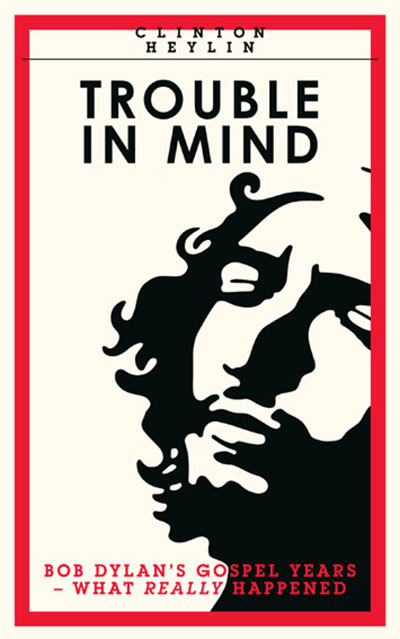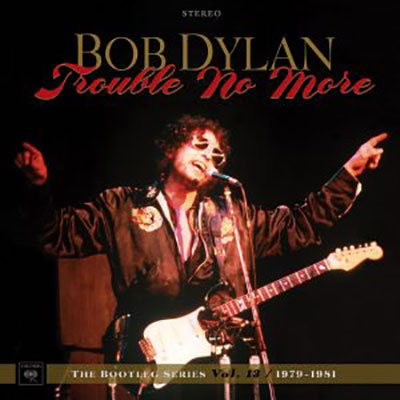
Trouble in Mind: Bob Dylan’s Gospel Years – What Really Happened?, Clinton Heylin (336pp, £16.99, Route Publishing)
Trouble No More: The Bootleg Series vol. 13/1979-1981. Bob Dylan (8CD + DVD, Columbia/Legacy)
When people ask me about Bob Dylan, I always answer that I’m not a big fan, but then I look at my shelves and realise there’s a foot-and-a-half or so of CDs there, including many unofficial album releases and live concert recordings. Like many others, something draws me back to his work, albeit specific periods or albums. For me it’s Desire and Blood on the Tracks that remain his most important works, along with the late 60s stuff, but there’s a sprinkling of most periods of his work up there, although I’m sceptical about the albums that every so often get announced by critics as ‘a return to form’.
Some of the live recordings I’ve got hold of are concerts from his so called ‘gospel years’. The Solid Rock, Rock Solid and Contract With the Lord bootlegs have been in circulation for a long time, so it’s no surprise to me that live versions of the rather dull albums Slow Train Coming, Saved and Shot of Love are finally getting the attention they deserve. Dylan has always been hit and miss in the studio, and seeemed especially so when recording these fervent religious songs. The live versions turn them into gospel music, powerful, muscular workouts; the unreleased songs sung at some of the concerts appear to be some of the most interesting and inventive tracks – why were they left off the official albums at the time?
It appears Dylan was suffering at the hands of the press, and from the expectant evangelical christian community he’d turned to for support and information, not to mention the fact he was churning out new songs in ‘born again’ excitement without time to document them properly. Thank goodness for live archives! Heylin is nonplussed by the religious fervour of Dylan at this time, quite rightly pointing out that Dylan had always been (and continues to be) a spiritual seeker, and that with hindsight the three albums fit into Dylan’s discography perfectly well.
He also points out that however shocking in some ways the concerts were, with no previous songs or greatest hits included, plus the fact Dylan was initially prone to preaching between tracks, the mass audience walkouts were pretty much an invention of journalists and reviewers at the time. Whilst there was some catcalling and jeering, many fans loved the concerts, and the tours in this period settled down into a righteous groove that even the most ardent atheist or perplexed agnostic could enjoy. And many did, critics included.
So why all the negativity? We’re all very good at adopting rock stars and musicians for our own causes, we all have our own hatred of certain belief systems, not many of us like being challenged about what we think. Spirituality is a private affair for most people., especially those with countercultural leanings. Whilst most fans accepted Dylan’s occasional explorations of his Jewish heritage, they were unprepared for him adopting a hellfire judgemental christianity, however rooted it was in the Jesus Movement which had happened a decade before. Radical and questioning theology appeared to have mutated into a more traditional, evangelical church, even if accompanied by rock music and fashionable dress. Dylan was perhaps unprepared for the expectations of the community who’d supported his wide-ranging explorations of the Bible with their pastors and priests.
Dylan has never really explained himself (why should he?), mostly relying on his songs to present his thinking at the time. The rants he offered audiences in his 1979 concerts were shockingly provocative and closed-minded, binary in their heaven or hell perspective, in the same way his gospel-only setlists were. Heylin suggests that he soon mellowed anyway, but also that many missed (and still miss) the questioning nature of some of the songs, as well as the humour of tracks like ‘Man Gave Names to All the Animals’. Interestingly enough, even at the time, but especially now, songs such as the ‘In the Garden’ (which was in many ways simply a retelling of a Biblical story as a series of questions) were critically acclaimed. Live it sparkles and shimmers musically, with swells of organ and backing vocals, and Dylan in fine voice. One can’t help but be caught up in the declamatory celebration.
By the end of the box set Dylan had started including old songs again, and his initial faith-full fervour had gone, but the songs have got better and better from constant revisiting and reinvention. Whilst many fans breathed a sigh of relief and critics claimed it all as a passing fad now abandoned, Heylin points out that although Dylan has questioned the phrase ‘born again’ and suggested it’s not term he would use now, he has never disowned those albums or spoken against what he said he believed. He has carried on exploring the spiritual, political and social, and if we still don’t really know what happened (despite Heylin’s best attempt in his fantastically informative, detailed and readable book) those with an open mind will enjoy hours of amazing new music and reading matter here.
Rupert Loydell

[Trouble No More is also available in a 2CD version]
